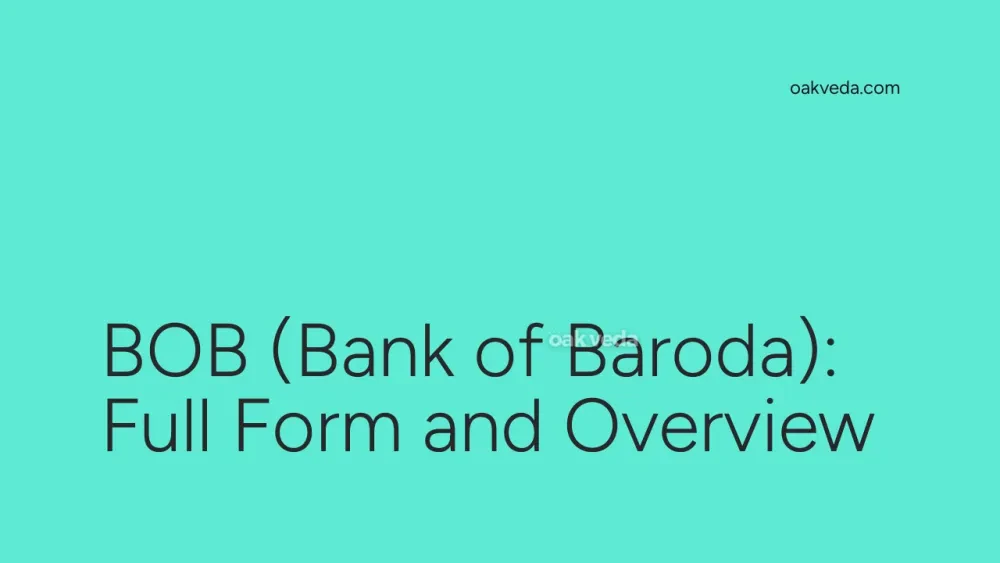
What is the Full Form of BOB?
The full form of BOB is Bank of Baroda. This acronym represents one of India's leading public sector banks, which has played a significant role in the country's financial landscape for over a century.
What is Bank of Baroda?
Bank of Baroda is a multinational public sector bank and financial services company headquartered in Vadodara, Gujarat, India. With its corporate office in Mumbai, BOB has established itself as a major player in the Indian banking sector. As of 2023, the bank boasts an extensive network of over 8,200 domestic branches and 96 overseas branches, making it one of the largest banking institutions in India.
Origin and Development of Bank of Baroda
The history of Bank of Baroda is deeply rooted in India's pre-independence era:
- Foundation: Maharaja Sayajirao Gaekwad III founded BOB on July 20, 1908, in the princely state of Baroda (now Vadodara).
- Early Expansion: In the 1950s, BOB began its international expansion, opening branches in Mombasa and Kampala (1953) and London (1957).
- Domestic Growth: The bank's first domestic acquisition was Hind Bank in 1958, followed by mergers with New Citizen Bank of India (1961) and Surat Banking Corporation (1963).
- Nationalization: On July 19, 1969, the Indian government nationalized BOB, transforming it into a public sector undertaking.
- International Presence: Throughout the 1970s and 1980s, BOB expanded its global footprint, establishing operations in Uganda, Dubai, Abu Dhabi, Bahrain, and Australia.
- Public Offering: In 1996, BOB approached the stock market with its Initial Public Offering.
- Recent Developments: In 2019, BOB merged with Dena Bank and Vijaya Bank, further solidifying its position in the Indian banking sector.
How does Bank of Baroda work?
Bank of Baroda operates as a full-service commercial bank, offering a wide range of financial products and services to various customer segments. Its operations are divided into several key areas:
- Retail Banking: Provides services like savings accounts, loans, and credit cards to individual customers.
- Corporate Banking: Offers financial solutions to large businesses and corporations.
- Rural and Agricultural Banking: Focuses on serving rural customers and supporting the agricultural sector.
- International Banking: Manages overseas operations and facilitates international transactions.
- Treasury Operations: Handles the bank's investments and manages liquidity.
Functions of Bank of Baroda
Bank of Baroda performs several crucial functions in the Indian financial ecosystem:
- Deposit Mobilization: Accepts various types of deposits from the public.
- Credit Disbursement: Provides loans and advances to individuals and businesses.
- Foreign Exchange Services: Facilitates international trade and remittances.
- Government Banking: Acts as an agent for government transactions.
- Digital Banking: Offers modern banking solutions through online and mobile platforms.
- Financial Inclusion: Promotes banking services in underserved areas.
Applications of Bank of Baroda Services
BOB's services find applications across various sectors and customer segments:
- Personal Finance: Helps individuals manage their savings, investments, and borrowing needs.
- Business Growth: Supports SMEs and large corporations with working capital and expansion financing.
- Agricultural Development: Provides specialized loans and services to farmers and agri-businesses.
- International Trade: Facilitates cross-border transactions for importers and exporters.
- Government Projects: Supports infrastructure development through project financing.
Features of Bank of Baroda
Bank of Baroda distinguishes itself through several key features:
- Extensive Network: Wide presence across India and international locations.
- Technological Innovation: Adoption of digital banking solutions and AI-powered services.
- Diverse Product Portfolio: Offers a comprehensive range of banking and financial products.
- Strong Government Support: Enjoys backing as a public sector bank.
- Focus on Financial Inclusion: Actively promotes banking services in rural and semi-urban areas.
Benefits of Bank of Baroda
Customers and stakeholders benefit from BOB in numerous ways:
- Reliability: As a government-backed institution, it offers financial security.
- Competitive Rates: Provides attractive interest rates on deposits and loans.
- Global Reach: Facilitates international banking needs through its overseas presence.
- Digital Convenience: Offers user-friendly online and mobile banking platforms.
- Specialized Services: Caters to specific sectors like agriculture and SMEs with tailored products.
Limitations or Challenges of Bank of Baroda
Despite its strengths, BOB faces certain challenges:
- Non-Performing Assets: Like many public sector banks, BOB has grappled with NPAs.
- Competition: Faces stiff competition from private banks and fintech companies.
- Technological Adaptation: Continuous need to upgrade systems and train staff in new technologies.
- Regulatory Compliance: Must navigate complex and evolving banking regulations.
Future Developments in Bank of Baroda
Looking ahead, Bank of Baroda is focusing on several areas for growth and improvement:
- Digital Transformation: Investing in advanced technologies like AI, blockchain, and cloud computing.
- Customer-Centric Approach: Enhancing customer experience through personalized services.
- Sustainable Banking: Increasing focus on green financing and sustainable development projects.
- Global Expansion: Exploring new international markets and strengthening existing overseas operations.
- Skill Development: Investing in employee training to meet evolving banking needs.
FAQs on BOB Full Form
-
What is the full form of BOB in banking? The full form of BOB in banking is Bank of Baroda.
-
When was Bank of Baroda established? Bank of Baroda was established on July 20, 1908.
-
Is Bank of Baroda a private or public sector bank? Bank of Baroda is a public sector bank, nationalized by the Indian government in 1969.
-
Where is the headquarters of Bank of Baroda located? The headquarters of Bank of Baroda is in Vadodara, Gujarat, with its corporate office in Mumbai.
-
How many branches does Bank of Baroda have? As of 2023, Bank of Baroda has over 8,200 domestic branches and 96 overseas branches.
In conclusion, the full form of BOB - Bank of Baroda - represents a financial institution that has been integral to India's banking sector for over a century. From its royal origins to its current status as a major public sector bank, BOB continues to evolve, embracing technological advancements and expanding its global footprint while serving millions of customers across India and beyond.
You may be interested in:

